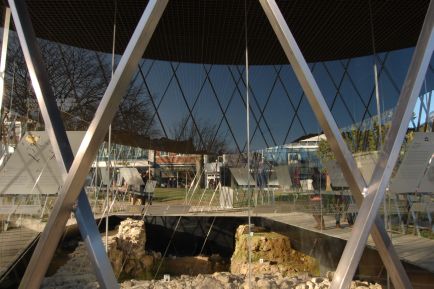
The Archaeological Showcase
Important archaeological finds are constantly being made during excavation work all over Aachen, and the grounds of the Elisengarten are no exception. Systematic digs here between 2007 and 2010 unearthed about 70000 archaeologically significant objects dating from the Neolithic through to the late Middle Ages. The "Archaeological Showcase", which was built by kadawittfeldarchitektur, offers views into 60 m2 of the original 2000 m2 excavation site.
The oldest finds to be seen here date from the Middle Neolithic period (4700-4550 BC): a stone on which a flint worker would have sat, and half-finished stone axes. The axe blades were fashioned from flint that was already being quarried on Lousberg from the 4th millennium BC on.
Flintstone and medical instruments
In the early Roman period, Aachen covered 20 to 30 hectares. The excavations show that the inhabitants at that time lived in half-timbered houses. In the course of the 1st century AC, they even erected the first few stone buildings with tiled roofs and painted walls. Luxury living in Roman times included wall and underfloor heating (hypocaustum). The Archaeological Showcase features remnants of this kind of heating system from the 3rd century AC.
In the 2nd and 3rd century AC, "Aquae Granni" was a flourishing township full of craftsmen and traders, its greatest attraction being its hot springs. All around Büchel, a complex of thermal baths and temples arose. One of the buildings whose remnants archaeologists found in the Elisengarten was probably a hostel where spa visitors and patients would have spent time in heated rooms each measuring 12 m2. Probes for the treatment of wounds and a pair of locking forceps unearthed on the site indicate that medical treatment was provided here.
In the 2nd century, a small temple (aedicula) was built inside the hostel. We do not know which deity the inhabitants worshipped there. By the end of the 2nd century, the temple had fallen into disuse.
Combs carved from bone
Some of the original Roman buildings continued to be inhabited until well into the Early Middle Ages. At the latest from the 8th century onwards, a palace complex arose, parts of it within the late Roman fortifications. Charlemagne had St Mary‘s Church built around 800. Remnants of a grave and part of a cellar date from Carolingian times.
Norman raids in the late 9th century may well be the reason for the decline of Aachen‘s population in the 10th and 11th centuries. Around 1100, the number of inhabitants increased again sharply. The last remnants of the Roman walls were demolished. The stones were used for new buildings, for example for the so-called town house (Stadthof) of the twin abbey of Stablo-Malmédy, from which large portions of wall have been preserved. In the former Roman foundation trenches, waste materials from a bone and antler carving workshop were found. Craftsmen used such materials to fashion tool handles, needles, combs or chess pieces.
Starting in 1171, the first city wall, Barbarossa‘s Wall, was erected around the medieval township. The course of the wall is traced in the cobblestones along the backside of today‘s Elisenbrunnen. In a cistern located outside the scope of the showcase, archaeologists discovered small clay and stone marbles. These were used in children‘s games, but also as ammunition for special blowpipes to hunt birds with.
More information:
www.archaeologische-vitrine.de
More information (German):
www.zeitreise.ac
www.aachen.de/elisengarten
Station Bath Culture
Elisenbrunnen
The thermal springs are where the township of Aachen originally started. They were the original reason for people settling here. In the framework of the Route Charlemagne, the Elisenbrunnen and the Archeological showcase in the Elisengarten complement the theme of "History".
Archeological showcase

